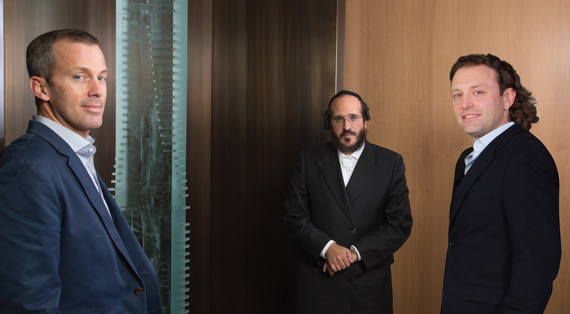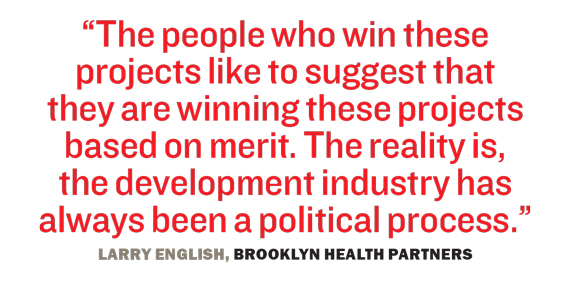Trending
The Fortis of solitude
The Long Island College Hospital controversy has thrust a mid-sized player</br> that values its privacy into the limelight

When construction workers began to dismantle the 156-year-old Long Island College Hospital earlier this year, it signaled the end of one bitter battle and the beginning of another. The 20-building medical facility, based in Cobble Hill, Brooklyn, shuttered in 2014, sparking outrage among employees, residents and community officials. Soon after the State University of New York announced its decision to close the hospital, LICH workers rallied. Those protests were followed by a series of lawsuits, seeking to keep a full-service hospital on the premises.
And the public ire quickly carried over to the developers that SUNY tapped to transform the site: Fortis Property Group [TRDataCustom], a company that has managed to stay out of the limelight for several years.
For the privately run, Dumbo-based real estate firm, buying the LICH site for $240 million last year was a major milestone. Since the company’s founding, in 2005, Fortis has developed only a handful of condominiums and rental buildings in New York City, primarily in Brooklyn. The majority of its acquisitions and investments have taken place in Dallas, Texas, and other cities far from New York.
“We didn’t get involved in your traditional, Billionaires’ Row projects even though they were available and we had the wherewithal to do so,” Fortis’ chief executive officer, Jonathan Landau, told The Real Deal in a sit-down interview in September. “We seek to enter into areas where our developments are distinctive and really elevate, and have an impact on, the marketplace.”
In addition, the company’s latest project will be one of its largest and most controversial. Fortis plans to either build market-rate condos or a much larger development that will feature both luxury and affordable housing on the site of the former community hospital. The latter would require a rezoning granted by the city — an option that has drawn fierce community opposition and for which key City Council members have shown little appetite. Meanwhile, federal officials are investigating Mayor Bill de Blasio’s role in the site’s sale, which included brokering a deal with SUNY to sell the property without requiring that LICH remain a full-service hospital.
 While the future of the site and the investigation that surrounds it remain uncertain, the planned redevelopment provides a rare glimpse at a company that has otherwise stayed under the radar. Industry insiders who spoke to TRD described Fortis as a firm run by shrewd investors who prefer to work alone on development projects and whose interests in New York real estate have remained something of a mystery.
While the future of the site and the investigation that surrounds it remain uncertain, the planned redevelopment provides a rare glimpse at a company that has otherwise stayed under the radar. Industry insiders who spoke to TRD described Fortis as a firm run by shrewd investors who prefer to work alone on development projects and whose interests in New York real estate have remained something of a mystery.
Now, as the company embarks on its most ambitious endeavor yet, the looming question is whether its executives are ready for a project of this complexity and the scrutiny that comes with it.
“At the end of the day, Fortis can say what they can and cannot do,” said Larry English, the former general counsel of Brooklyn Health Partners, who headed a team that ultimately lost out on buying LICH. “But they have never built a project of that size and caliber.”
Slow and steady
As a Brooklyn-based developer with fewer than 70 employees, Fortis doesn’t easily fit into a mold. The company is more institutional than Yoel Goldman’s All Year Management or Simon Dushinsky’s Rabsky Group, less prolific than Slate Property Group or Adam America Real Estate, and a smaller shop than Two Trees Management or Forest City Ratner Companies.
“They’re not serial developers doing five to 10 projects a year,” said Ofer Cohen, of the Brooklyn-based commercial brokerage TerraCRG. “They seek out deep value-add, large-scale projects with a lot of complexity, and these deals are few and far between. We’ve shown them a few potential deals, but everything was ‘too normal’ for them.”
The company’s presence in the city has been a slow climb since Fortis got off the ground 11 years ago. Louis Kestenbaum, a well-known member of Brooklyn’s Hasidic community, his son Joel, and Landau, a former transactional tax attorney with DLA Piper, founded the company with the goal of expanding Kestenbaum’s development endeavors and allowing him to stay on the transaction-side of the business.
The elder Kestenbaum first met Landau — a modern Orthodox Jew from Cleveland, Ohio — as he was looking to bring on a joint venture partner at 184 Kent Avenue in Williamsburg, Brooklyn, in the early 2000s.
Landau represented Kestenbaum on the deal, and the two got to know each other over the next few years as they worked together on additional projects. The two men worked well together on a few sophisticated deals, including the luxury Williamsburg condo towers Northside Piers, and established a relationship more akin to business partners than attorney and client.
At the time, Kestenbaum was a sort of one-off developer who also ran a sportswear business. The two decided to team up to build a more official venture, bringing on Landau’s colleague from DLA Piper, Terrence Storey, as the company’s chief financial officer and Joel Kestenbaum as president. Landau assumed the title of CEO, and Louis Kestenbaum took on the role of chairman.
In its first two years, Fortis acquired some $3 billion in cash-flowing properties, primarily Class A office buildings in Dallas, Boston and Norfolk, Connecticut.
Though the elder Kestenbaum had developed projects on his own prior to Fortis, he intentionally shied away from ground-up development projects in New York for the company’s first six years, due to high land prices. Right before the market came down in 2008, Fortis hired Akiva Kobre, the former vice president of New York’s Touro College, to lead its development projects.
“We were anticipating that at some point we would find the right project to launch our development platform,” Landau said. “In about 2010, 2011, the market seemed to be entering early stages of recovery, and we felt it was an opportune time to acquire development sites here in New York City.”
To ease into that arena, Fortis purchased 37 unsold condo units at 20 Bayard Street in Williamsburg for $25 million in 2011. The condo’s sponsors, who had sold off the other 25 units in the building, filed for bankruptcy two years prior, and the Fortis executives viewed the project as a sort of rehab mission. The company quickly stepped in and sold off the remaining units in the building.
From there, Fortis embarked on several condo developments along the Brooklyn waterfront, as well as one of its first Manhattan projects, at 540 West 49th Street in Hell’s Kitchen.
Strategic buys
In the fall of 2013, the company purchased two adjacent development sites at 151-161 Maiden Lane, near the South Street Seaport, for $64 million. Fortis drafted plans for a 60-story, 80-unit condo tower at 161 Maiden Lane and sold the other parcel for $32 million to Staten Island-based developer Richard Lou, who plans to build a Marriott hotel there.

A rendering of 1 Seaport
David Harte, of the real estate capital markets brokerage Ackman-Ziff Real Estate Group — who has advised Fortis on several transactions — said the decision to sell the hotel site speaks to the company’s knack for strategy. He noted that other sponsors who had eyed the site considered it a package deal: a mixed-use hotel-and-condo development.
“No one else seemed to be taking it in that direction, and they did,” Harte said. “They make good buys, and I think they are very shrewd about the deals they go after.”
The 161 Maiden Lane project, however, suffered a blow in September 2015, when developer Jack Resnick & Sons filed a lawsuit against Fortis alleging that the project’s moniker “1 Seaport” ripped off the name of its One Seaport Plaza office tower at 199 Water Street. The two developers settled the lawsuit two months later, with Fortis agreeing to stop using the name after a specified marketing period. Landau declined to say what the condo tower will be called once he and his associates abandon “1 Seaport.”
Several investment sales brokers who have worked with Fortis said it’s been a challenge finding the right acquisition opportunities to show the firm’s executives, due to their extremely calculated approach. While Fortis has acquired and developed rental properties in various cities, the company is not interested in operating these assets in New York City and has sold them off, according to sources.
One broker, who spoke on the condition of anonymity, described the firm as “difficult to understand” at first. But now, that broker said, Fortis “seems to have found its niche” in luxury residential development. Meanwhile, the company has established a business philosophy of only embarking on development projects in New York City.
Fortis also selectively brings on outside partners for its development projects. The company teamed with Amnon Shalhov’s Joy Construction Corporation to build Atelier Williamsburg, a six-story, 120-unit rental building that the joint venture sold to Sam Zell’s Equity Residential for $80 million in March. The size of Joy’s equity stake in the recently completed project was not disclosed.
Fortis will syndicate equity on its operating properties, but doesn’t like to dilute its stake in development projects, which demand more time and energy, Landau noted.
He said this was one of the reasons he and his associates went with the private, non-bank lender and investor Madison Realty Capital to finance its acquisition of the LICH site.
“Madison offered us an opportunity to leverage the property at a reasonably priced cost of funds relative to the dilution we would have taken if we brought in a partner,” Landau said.
The firm initially named Manhattan-based L+M Development Partners as a potential partner on the project. But the affordable-housing developer pulled out in August 2014 as it remained unclear if the project would include an affordable component. Representatives for L+M did not return calls for comment.
Colored past
Before Fortis, there was the Kestenbaum family, whose business ventures ranged from modest real estate transactions to women’s apparel and beauty products.
Some of those endeavors became embroiled in scandal — Louis, his brother Moshe Kestenbaum, and Kiryas Joel, New York-based developer Mayer Hirsch were indicted in 1999 in an Ohio federal court on charges of wire fraud and money laundering. Officials alleged that the men schemed to get discounts on health and beauty products from Procter & Gamble by pretending that the products were intended for the Soviet Union, when in reality they were shipped to a Brooklyn warehouse. The defendants were never convicted, however, and some of the charges in the case were ultimately dismissed through a 2005 plea agreement. The charges against Kestenbaum and four others were dropped through a separate order for dismissal.
The Kestenbaum family’s ties in Brooklyn run deep. Louis’ father, Rabbi Zvi Kestenbaum, formed the Opportunity Development Association (ODA), a community development agency in South Williamsburg, in 1974. Zvi, a Holocaust survivor and a fixture of Brooklyn’s Satmar Hasidic Jewish movement, served as president of the ODA Primary Health Care Network, a nonprofit health care arm of his organization.
Assemblyman Joseph Lentol, who represents parts of Williamsburg and Downtown Brooklyn and is a longtime friend of the Kestenbaum family, said that ODA serves as a sort of link to the “secular world” for some members of the Hasidic Jewish community. The agency directs many people to the right places to get business loans, and generally connects them with outside resources with which they are unfamiliar. Louis, who now serves as chairman of the health care network, is more interested in business than his father was, Lentol said.
“Zvi’s sons and grandson did better than him in business,” the assemblyman told TRD. “He encouraged them to do things the right way. They figured out they could do both — help people and also make money.”
A source in the insular Hasidic enclave in Brooklyn referred to Louis as an influential leader in the community. The developer, who’s in his mid-60s, is outgoing and social, while his son, Joel, who’s in his mid-30s, “wants to make a buck,” that source said. Both, however, often remain behind the scenes. The Kestenbaums declined to comment for this story.
“Louis is very much about his name. His ego is from here to Australia,” said Gary Schlesinger, who runs ParCare Community Health Network, a rival Brooklyn-based health care company.
 “He has always been about power and control. When he buys something, he makes sure nothing gets in his way,” Schlesinger said.
“He has always been about power and control. When he buys something, he makes sure nothing gets in his way,” Schlesinger said.
Landau, who’s 41, earned his law degree from the University of Maryland and spent six years at DLA Piper before joining Fortis. He now splits his time between Manhattan and Baltimore, where he lives with two of his three children, and Dallas, where he also owns property, he said. In addition to his more liberal religious background, Landau is also more comfortable with public attention than the Kestenbaums.
At a yacht party to celebrate 1 Seaport, he casually joked with colleagues and reporters, and even offered up his political preferences: He’s a staunch Donald Trump supporter with little regard for Democratic candidate Hillary Clinton.
Repurposing LICH
The LICH project is new territory for Fortis, on more than one level. It’s a large-scale redevelopment that could require navigating the labyrinth of the city’s land-use rules, and it’s a public project that comes with a heightened level of criticism.
“It was a little trickier and there were more barriers to entry that dissuaded other buyers,” Ackman-Ziff’s Harte said. “[Fortis] is very understated, and I think this was a little more public than they’re used to. But in terms of the bricks and mortar and working it through, it’s not too different. They’re buying it at a good basis.”
Fortis closed on the LICH deal after negotiations between SUNY and two other bidders fell apart. First it was the Brooklyn Health Partners, a nonprofit co-formed by California developer Merrell Schexnydre specifically to bid for LICH. But SUNY jettisoned the nonprofit in May 2014 because the two parties couldn’t come to a “satisfactory contract agreement,” according to the state university.
Though SUNY named BHP as the top bidder just a month earlier — the nonprofit had offered $250 million for the site — the university announced that it didn’t feel the team could complete the project. BHP, which had never built anything in New York, lobbed a lawsuit against SUNY in an attempt to block the sale of the site to another developer. But the case was ultimately dismissed.
SUNY then began negotiations with developer Don Peebles, the second-highest bidder, but the two parties couldn’t reach a deal either. The state later turned to Fortis, and the $240 million sale closed in September 2015.

Larry English
English, who led the LICH negotiations on behalf of BHP, told TRD he was disappointed that SUNY was unable to make a deal with either of the top bidders, both led by African-American men. He said that after BHP was kicked off the project, he met with Fortis in what he thought was going to be an opportunity to partner on the LICH deal. It became immediately clear, however, that Fortis had no intention of working together, English noted.
The winning team, according to SUNY’s request for proposals, was required to show that it made a conscious effort to employ minority- and women-owned companies as subcontractors. But English said that his organization’s meeting with Fortis was little more than a performance for the state. In its proposal for the site, Fortis identified another minority-owned business, Full Spectrum NY, as a partner. Full Spectrum did not respond to inquiries, while Landau would not comment beyond saying that Fortis has complied with all the RFP’s requirements.
“At the end, the real estate industry is a very small world. And New York, in a lot of ways, is a very small town,” English said. “The people who win these projects like to suggest that they are winning these projects based on merit. The reality is, the development industry has always been a political process.”
The sale continues to draw scrutiny from federal and local officials. In July, the New York Post reported that Preet Bharara, the U.S. Attorney for the Southern District of New York, subpoenaed SUNY for all communications between the university and Mayor de Blasio, along with several of his top aides. The mayor’s ties to LICH date back to his days as the city’s public advocate. At the time, de Blasio campaigned to keep LICH open and was even arrested in 2013 at a rally protesting the hospital’s closure. Once he entered City Hall, however, he brokered a deal with SUNY to keep health care services at the site, but not necessarily a full-fledged hospital.
The mayor also came out in support of Fortis’ plan to rezone the site to build a project that would include affordable housing and a medical facility run by New York University Langone Medical Center. Fortis, for its part, hired James Capalino, a lobbyist with close ties to the mayor, to engage with de Blasio’s aides about the hospital site’s sale. The mayor has publicly denied any wrongdoing in connection with LICH, but other public figures see it differently.
The sale of the hospital site inspired New York State Senator Daniel Squadron to introduce a bill titled the LICH Act (the acronym standing for Local Input in Community Healthcare). The bill would require the State Department of Health to alert the public of the impact of a hospital’s closing and to hold a public forum. The State Assembly passed the bill in June 2015, but it didn’t make it through the State Senate. Squadron told TRD last month that he plans to revive the bill.
“I’m continuing to push the LICH Act to ensure communities have a voice in the health care process, which didn’t happen at LICH,” he said. “The impacts of LICH’s closure have been doubly bad for the community: less health care and proposed out-of-context development without community benefit.”
Charging ahead
The Fortis executives have two options for the former hospital site: They can either build 528,935 square feet of market-rate apartments as of right, or go through the process of trying to rezone the site to build 900,000 square feet of luxury housing and 225,000 square feet of affordable housing.
The company previously showed interest in purchasing a bankrupt hospital in Bayonne, New Jersey, in 2007, but ultimately opted out of redeveloping the property. When the deal fell through, Fortis and its then-intermediary, Robert Miller, had a major falling out. The company alleged that Miller signed a purchasing agreement for the site without its permission, which dragged Fortis into the hospital’s bankruptcy proceedings and related litigation. The lawsuit was ultimately dismissed, and Landau told TRD that the issues with the Bayonne site in no way impacted Fortis’ decision to pursue LICH.
The company is still finalizing its plans for the site, according to Landau. Though some opponents argue that the project isn’t financially feasible without upzoning the site, Landau said Fortis’ as-of-right development plan is a good one.
“I think we went in with eyes wide open,” the company’s CEO said. “And if we ultimately decide to go as of right, we won’t be disappointed. We understood what it meant to potentially seek a rezoning in a traditional neighborhood in Brooklyn.”
Landau added: “We have zero intention of making an investment in a property and not executing to the highest level.”
For the time being, Fortis has moved forward with one component of the LICH project — the condo conversion of the landmarked Polhemus Building, which formerly served as a free medical clinic. The site will soon be home to eight townhouses and 17 condo units. The rest of the project will be sorted out in the coming months, Landau said.
“They’re exploring their options and waiting for the dust to settle,” said Citi Habitats’ Dave Maundrell, who handled leasing at the Atelier Williamsburg. “A lot of people are fiery over it, and with good reason. The firm doesn’t want to be involved in the spotlight, but ultimately the returns can be much greater than that of other projects — regardless of the publicity.”




